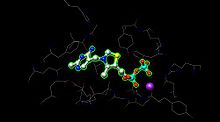Pyruvate dehydrogenase
| pyruvate dehydrogenase (acetyl-transferring) | |||||||||
|---|---|---|---|---|---|---|---|---|---|
ExPASy NiceZyme view | | ||||||||
| KEGG | KEGG entry | ||||||||
| MetaCyc | metabolic pathway | ||||||||
| PRIAM | profile | ||||||||
| PDB structures | RCSB PDB PDBe PDBsum | ||||||||
| Gene Ontology | AmiGO / QuickGO | ||||||||
| |||||||||
Pyruvate dehydrogenase is an

Pyruvate dehydrogenase is usually encountered as a component, referred to as E1, of the
Mechanism

The thiamine pyrophosphate (TPP) converts to an ylide by deprotonation. The ylide attack the ketone group of pyruvate. The resulting adduct decarboxylates. The resulting 1,3-dipole reductively acetylates lipoamide-E2.[2]
In terms of details, biochemical and structural data for E1 revealed a mechanism of activation of TPP coenzyme by forming the conserved hydrogen bond with glutamate residue (Glu59 in human E1) and by imposing a V-conformation that brings the N4’ atom of the aminopyrimidine to intramolecular hydrogen bonding with the thiazolium C2 atom. This unique combination of contacts and conformations of TPP leads to formation of the reactive C2-carbanion, eventually. After the cofactor TPP decarboxylates pyruvate, the acetyl portion becomes a hydroxyethyl derivative covalently attached to TPP.[1]
Structure
E1 is a multimeric protein. Mammalian E1s, including human E1, are tetrameric, composed of two α- and two β- subunits.[1] Some bacterial E1s, including E1 from Escherichia coli, are composed of two similar subunits, each being as large as the sum of molecular masses of α- and β- subunits.[3]

Active site

E1 has two catalytic sites, each providing thiamine pyrophosphate (TPP) and magnesium ion as cofactors. The α- subunit binds magnesium ion and pyrophosphate fragment while the β-subunit binds pyrimidine fragment of TPP, forming together a catalytic site at the interface of subunits.[1]
The active site for pyruvate dehydrogenase (image created from PDB: 1NI4) holds TPP through metal ligation to a magnesium ion (purple sphere) and through hydrogen bonding to amino acids. While over 20 amino acids can be found in the active site, amino acids Tyr 89, Arg 90, Gly 136, Val 138, Asp 167, Gly 168, Ala 169, Asn, 196, and His 263 actually participate in hydrogen bonding to hold TPP and pyruvate (not shown here) in the active site. The amino acids are shown as wires, and the TPP is in ball and stick form. The active site also aids in the transfer of the acyl on the TPP to a lipoamide waiting on E2.[1]
Regulation

Pathology
Pyruvate dehydrogenase is targeted by an
Increased pyruvate dehydrogenase (PDH) activity can cause oncogene-induced cellular senescence, as well as promoting aging.[6] Decreased activity of mitochondrial PDH with age has been shown in the heart as well as in certain regions of the brain (the striatum and brainstem).[6]
Pyruvate dehydrogenase (PDH) deficiency is a congenital degenerative metabolic disease resulting from a mutation of the pyruvate dehydrogenase complex (PDC) located on the X chromosome. While defects have been identified in all 3 enzymes of the complex, the E1-α subunit is predominantly the culprit. Malfunction of the citric acid cycle due to PDH deficiency deprives the body of energy and leads to an abnormal buildup of lactate. PDH deficiency is a common cause of lactic acidosis in newborns and often presents with severe lethargy, poor feeding, tachypnea, and cases of death have occurred.[7]
Examples
Human proteins that possess pyruvate dehydrogenase activity include:
|
|
| ||||||||||||||||||||||||||||||
Related enzymes
In
See also
References
- ^ PMID 12651851.
- ^ ISBN 978-0-7167-8724-2.
- PMID 11955070.
- PMID 26142699.)
{{cite journal}}: CS1 maint: numeric names: authors list (link - PMID 17657817.
- ^ S2CID 19807849.
- ^ Pyruvate Dehydrogenase Complex Deficiency at eMedicine
- PMID 6752142.
- PMID 11390679.
- Ochoa S (1954). "Enzymic Mechanisms in the Citric Acid Cycle". Advances in Enzymology and Related Areas of Molecular Biology. Advances in Enzymology - and Related Areas of Molecular Biology. Vol. 15. pp. 183–270. )
- Scriba P, Holzer H (1961). "Gewinnung von alphaHydroxyathyl-2-thiaminpyrophosphat mit Pyruvatoxydase aus Schweineherzmuskel". Biochem. Z. 334: 473–486.
- Perham RN (2000). "Swinging arms and swinging domains in multifunctional enzymes: catalytic machines for multistep reactions". Annual Review of Biochemistry. 69 (1): 961–1004. PMID 10966480.
External links
- Pyruvate+Dehydrogenase-E1 at the U.S. National Library of Medicine Medical Subject Headings (MeSH)
- http://www.brookscole.com/chemistry_d/templates/student_resources/shared_resources/animations/pdc/pdc.html Archived 2012-07-24 at the Wayback Machine
- PDBe-KB provides an overview of all the structure information available in the PDB for Human Pyruvate dehydrogenase (lipoamide) alpha 1.
- PDBe-KB provides an overview of all the structure information available in the PDB for Human pyruvate dehydrogenase (lipoamide) beta.










